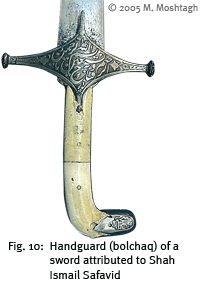WATERED STEEL
 The book contains information with regard to the classification of watered steel by al Kindi, Beiruni, Ibn Sina, etc. and a comparative analysis of the research in this field. For the first time, the classification of watered steel in Noroozname by Omar ibn Khayyam Neishaburi, the renowned Persian poet and mathematician from the 11th century, is examined. The development of swords from double-edged blades into single-edged sabers encompasses an important part of this text. Many valuable primary sources, such as Adab al Harb va Shojae by Mobarakshah ben Mansur, Noroozname by Khayyam
The book contains information with regard to the classification of watered steel by al Kindi, Beiruni, Ibn Sina, etc. and a comparative analysis of the research in this field. For the first time, the classification of watered steel in Noroozname by Omar ibn Khayyam Neishaburi, the renowned Persian poet and mathematician from the 11th century, is examined. The development of swords from double-edged blades into single-edged sabers encompasses an important part of this text. Many valuable primary sources, such as Adab al Harb va Shojae by Mobarakshah ben Mansur, Noroozname by Khayyam  Neishaburi, and secondary Iranian sources, are consulted to establish a solid cultural foundation for the development of edged weapons. Beautiful examples of Iranian shamshirs (swords) attributed to Iranian kings and rulers are illustrated. Included are powerful images of shamshirs without fullers (shamshir attributed to Shah Ismail Safavid), with fullers (shamshir attributed to Shah Safi), highly curved blades (shamshir attributed to Karim Khan Zand), and slightly curved and serrated blades (shamshir attributed to Shah Suleiman Safavid), proving that different styles of swords coexisted with each other. One of the hallmarks of the text is the analysis of three shamshirs that are attributed to Timur. Additionally disclosed is some proof that the highly curved Iranian sword (shamshir) was
Neishaburi, and secondary Iranian sources, are consulted to establish a solid cultural foundation for the development of edged weapons. Beautiful examples of Iranian shamshirs (swords) attributed to Iranian kings and rulers are illustrated. Included are powerful images of shamshirs without fullers (shamshir attributed to Shah Ismail Safavid), with fullers (shamshir attributed to Shah Safi), highly curved blades (shamshir attributed to Karim Khan Zand), and slightly curved and serrated blades (shamshir attributed to Shah Suleiman Safavid), proving that different styles of swords coexisted with each other. One of the hallmarks of the text is the analysis of three shamshirs that are attributed to Timur. Additionally disclosed is some proof that the highly curved Iranian sword (shamshir) was  known for a long time before Shah Abbas -Safavid’s rise to power. Two of these blades show separate gold-inlay with different datings and names. This, of course, is an indication that these swords were used as hereditary swords from one generation to the next.
known for a long time before Shah Abbas -Safavid’s rise to power. Two of these blades show separate gold-inlay with different datings and names. This, of course, is an indication that these swords were used as hereditary swords from one generation to the next.
